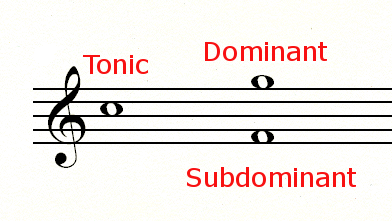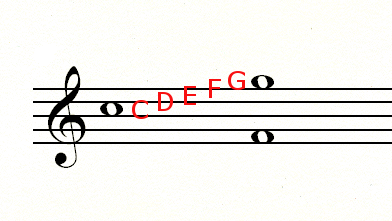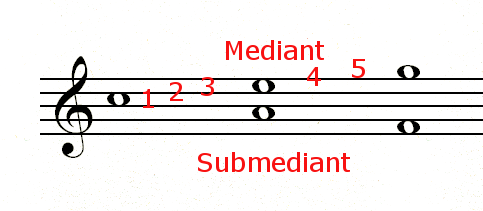1.9: Scale Degrees of the Diatonic Scale
- Page ID
- 51977
\( \newcommand{\vecs}[1]{\overset { \scriptstyle \rightharpoonup} {\mathbf{#1}} } \)
\( \newcommand{\vecd}[1]{\overset{-\!-\!\rightharpoonup}{\vphantom{a}\smash {#1}}} \)
\( \newcommand{\id}{\mathrm{id}}\) \( \newcommand{\Span}{\mathrm{span}}\)
( \newcommand{\kernel}{\mathrm{null}\,}\) \( \newcommand{\range}{\mathrm{range}\,}\)
\( \newcommand{\RealPart}{\mathrm{Re}}\) \( \newcommand{\ImaginaryPart}{\mathrm{Im}}\)
\( \newcommand{\Argument}{\mathrm{Arg}}\) \( \newcommand{\norm}[1]{\| #1 \|}\)
\( \newcommand{\inner}[2]{\langle #1, #2 \rangle}\)
\( \newcommand{\Span}{\mathrm{span}}\)
\( \newcommand{\id}{\mathrm{id}}\)
\( \newcommand{\Span}{\mathrm{span}}\)
\( \newcommand{\kernel}{\mathrm{null}\,}\)
\( \newcommand{\range}{\mathrm{range}\,}\)
\( \newcommand{\RealPart}{\mathrm{Re}}\)
\( \newcommand{\ImaginaryPart}{\mathrm{Im}}\)
\( \newcommand{\Argument}{\mathrm{Arg}}\)
\( \newcommand{\norm}[1]{\| #1 \|}\)
\( \newcommand{\inner}[2]{\langle #1, #2 \rangle}\)
\( \newcommand{\Span}{\mathrm{span}}\) \( \newcommand{\AA}{\unicode[.8,0]{x212B}}\)
\( \newcommand{\vectorA}[1]{\vec{#1}} % arrow\)
\( \newcommand{\vectorAt}[1]{\vec{\text{#1}}} % arrow\)
\( \newcommand{\vectorB}[1]{\overset { \scriptstyle \rightharpoonup} {\mathbf{#1}} } \)
\( \newcommand{\vectorC}[1]{\textbf{#1}} \)
\( \newcommand{\vectorD}[1]{\overrightarrow{#1}} \)
\( \newcommand{\vectorDt}[1]{\overrightarrow{\text{#1}}} \)
\( \newcommand{\vectE}[1]{\overset{-\!-\!\rightharpoonup}{\vphantom{a}\smash{\mathbf {#1}}}} \)
\( \newcommand{\vecs}[1]{\overset { \scriptstyle \rightharpoonup} {\mathbf{#1}} } \)
\( \newcommand{\vecd}[1]{\overset{-\!-\!\rightharpoonup}{\vphantom{a}\smash {#1}}} \)
Scale Degrees
In music we discuss the seven steps of diatonic scales in two different ways. Sometimes we reference the scale steps with numbers:

In this C major scale, for instance, scale degree 4 is an F. The 8th scale degree is the same note name as the 1st scale degree.
Secondly, each scale degree also has a unique name, one that will be often applied to harmonies built on the scale degree. Before we introduce all the scale degrees in the order they appear in the diatonic scale, let’s first explain how the scale degrees are related.

The note name of each scale (here C major) or the first scale degree is called the “tonic.” This is the central note in the tonal scale or key. The next most important note is termed “dominant” for the large role (dominant role) it plays in tonal compositions. Many compositions end with chords built upon the dominant and tonic of the key. Notice that the dominant is located on the 5th scale degree—on the fifth alphabet letter of the scale:

The subdominant (lower dominant) mirrors the dominant. It is below the tonic by five scale steps. “Subdominant” is below the tonic just as “submarines” are below the surface of the ocean. Count out the five steps so you verify that the subdominant is five steps below the tonic. (C, B, A, G, F)
The mediant and submediant are also arranged in mirror images around the tonic:

“Mediant” means middle. Thus, the mediant is in the middle of the tonic and domiant, on the 3rd scale step. The submediant is in the middle of the tonic and subdominant.
The last two scale degrees, 2 and 7 are arranged around the tonic. The “supertonic” is above the tonic on the second scale degree. The “leading tone” is an important scale step that leads to the tonic both melodically and harmonically. You will learn more about this important scale step in your later studies.
Here are the names of the scale degrees on the C major scale:



